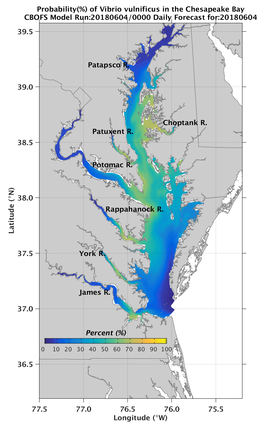NOAA Operational Forecast System-Related Guidance Products for Waterborne Pathogens in the Chesapeake Bay
OFS Chesapeake Bay Vibrio Forecasts
The presence of Vibrio vulnificus (Vv), a naturally-occurring bacteria that can be harmful to human health, is related to temperature and salinity. Vv forecasts for the Chesapeake Bay based on Operational Forecast Systems (CBOFS) include daily and next day probability forecast guidance on the CBOFS model grid. The occurrence of Vv is predicted by forcing a statistical model with physical variables: temperature and salinity averaged over top 1 meter and over 24 hours centered on 06Z of the current day. The resolution of the CBOFS irregular grid ranges from 34m and 29m in the x and y directions, respectively to 4895m and 3380m.
- Cite as: Jacobs, John; Daniels, Robert; Zhang, Aijun; Zheng, Lianyuan. (2018). NOAA Operational Forecast System-Related Guidance Products for Waterborne Pathogens in the Chesapeake Bay. NOAA National Centers for Environmental Information. doi: 10.25921/07vb-3427. [access date]
- doi: 10.25921/07vb-3427
- NCEI DSI 6153_01
- gov.noaa.ncdc:C01548
C01548
| Download Data |
|
| Distribution Formats |
|
| Ordering Instructions | Contact NCEI for other distribution options and instructions. |
| Distributor | NOAA National Centers for Environmental Information
ncei.info@noaa.gov |
| Dataset Point of Contact | Customer Service
DOC/NOAA/NESDIS/NCEI > National Centers for Environmental Information, NESDIS, NOAA, U.S. Department of Commerce +1 301-713-3277 NODC.Services@noaa.gov |
| Time Period | 2015-04-01 to Present (time interval: 24-hour) |
| Spatial Bounding Box Coordinates |
N: 39.62
S: 36.19
E: -74.81
W: -77.32
|
| Spatial Coverage Map | |
| Dataset Information |
|
| General Documentation |
|
| Processing Documents |
|
| Publication Dates |
|
| Data Presentation Form | Digital image
|
| Dataset Progress Status | Ongoing - data is continually being updated |
| Data Update Frequency | Continual |
| Purpose | Intended use includes researchers studying the impacts or ecology of Vibrio and pathogens, and emergency managers in need of historical Vibrio vulnificus data. |
| Use Limitations |
|
| Dataset Citation |
|
| Cited Authors |
|
| Principal Investigators |
|
| Collaborators |
|
| Resource Providers |
|
| Publishers |
|
| Theme keywords | Global Change Master Directory (GCMD) Science Keywords
|
| Data Center keywords | Global Change Master Directory (GCMD) Data Center Keywords
|
| Platform keywords | Global Change Master Directory (GCMD) Platform Keywords
|
| Instrument keywords | Global Change Master Directory (GCMD) Instrument Keywords
|
| Place keywords | Global Change Master Directory (GCMD) Location Keywords
|
| Data Resolution keywords | Global Change Master Directory (GCMD) Temporal Data Resolution Keywords
|
| Stratum keywords | Global Change Master Directory (GCMD) Location Keywords
|
| Use Constraints |
|
| Access Constraints |
|
| Fees |
|
| Lineage Statement | Source data are NOAA CO-OPS Chesapeake Bay Operational Forecast System (CBOFS) model data including water temperature and salinity, and NOAA CBO Chesapeake Bay Interpretive Buoy System (CBIBS) hourly buoy measurements of temperature and salinity. Prior to May 2018, data were managed by NCCOS as experimental data. For this period, two dates were not available to send to the archive: July 11 and July 21, 2016. In 2018, the data product went operational and management of data production transferred to NOAA CO-OPS. During this transfer of management, the eligible pre-2018 data files were re-engineered to match the operational processing of the data. Also, the pre-2018 data files contain 25 time steps per forecast day while the newer 2018 data contains 24 time steps. In 2018, the CBOFS model discontinued the f00 time step that was used in the time averaging for the Vibrio model. |
| Processor |
|
| Processing Steps |
|
| Processing Documents |
|
| Source Datasets |
|
| Processing Steps |
|
Last Modified: 2023-06-23
For questions about the information on this page, please email: ncei.info@noaa.gov
